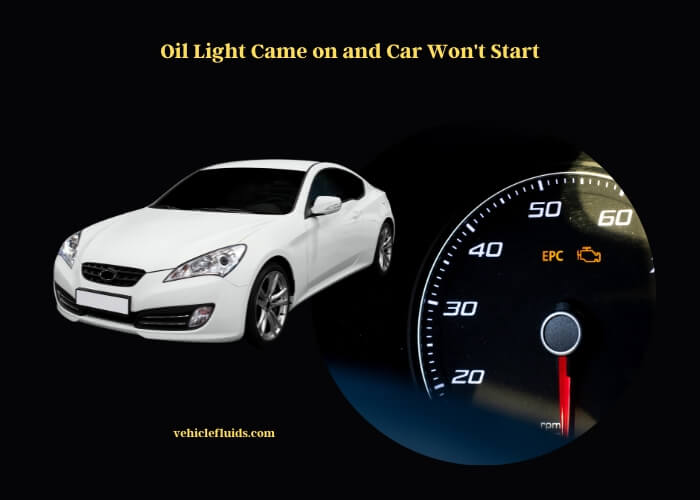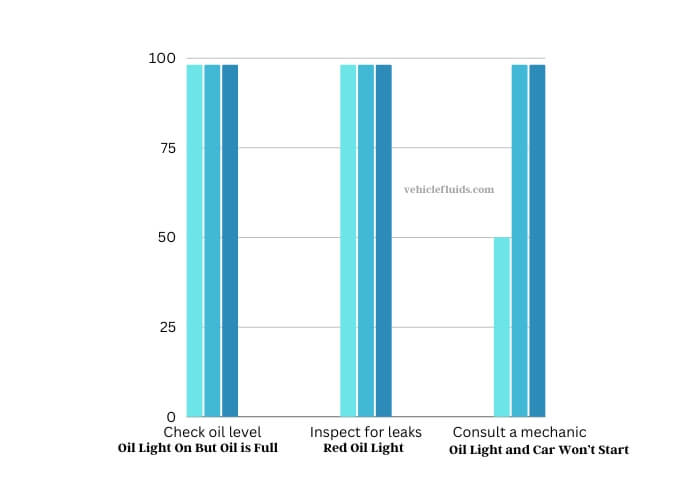When the oil light illuminates on your dashboard and your car refuses to start, it can be a distressing situation. This warning light is primarily a signal of potential issues related to the oil pressure in your vehicle.
In many vehicles, the oil light serves as an indicator of oil pressure rather than oil level. If this light comes on while starting your car and then turns off, it’s generally a normal indication that the system has successfully gauged the oil pressure. If your car’s oil light comes on even when the oil level is full, it can indicate a problem with the oil pressure sensor, or perhaps an issue within the oil delivery system.

There are instances where a vehicle won’t start, and both the battery and oil light are on. This scenario suggests a potential battery or electrical system problem rather than just an oil-related issue. If your car stalls and the oil light illuminates, it’s often a result of the engine not running and hence not generating oil pressure.
It’s not guaranteed that merely adding oil will enable your car to start. However, it can sometimes rectify the situation if the oil level was critically low. If you’re uncertain about the amount of oil remaining when the light comes on, it’s always best to check the dipstick. A red oil light typically indicates a severe pressure drop and demands immediate attention.
In any case, when the oil light comes on, it’s crucial to address it promptly. Whether it’s refilling the oil, checking for possible leaks, or consulting a mechanic, swift action can prevent potential long-term engine damage.
Navigating the Dilemma: ‘Oil Light Came On and Car Won’t Start’
Imagine you’re about to head out for an important errand, and bam! The dreaded oil light pops up on your dashboard, and your car refuses to start. It’s a bummer, right? Let’s tackle this issue together, step by step.
Oil Light Basics: What Does It Indicate?
The Role of the Oil Light in Vehicles
So, think of the oil light as a vigilant guard for your car’s engine. It’s there to alert you when something’s off with the engine’s lubrication system. Either there’s not enough oil, or there’s an issue with how the oil’s circulating.
Oil Pressure vs. Oil Level: What’s the Difference?
Often, we think these are the same. But they’re not. Oil level is the amount of oil in the engine. Pretty straightforward, right? On the flip side, oil pressure is about how this oil moves and circulates. If it’s not flowing right, it can’t protect your engine parts.
Common Oil Light Scenarios and Their Implications
When the Oil Light Flickers and Goes Off During Startup
You start your car, and for a split second, that pesky oil light flashes and then disappears. Does it spell trouble? Not always. It’s usually the car’s way of saying it’s checked the oil pressure and everything’s in order.
Persistent Oil Light Even with a Full Oil Tank
Alright, this one’s a head-scratcher. You’ve just checked, and the oil’s brimming. Why then is the light still on? It might be hinting at an issue with the oil pressure sensor or a hiccup in the oil delivery system. A mechanic visit might be on the horizon.
Encountering a Red Oil Light: Immediate Steps
Seeing red is never a good sign. A red oil light is the car’s way of screaming, “Help! I need attention!” It typically indicates a serious drop in oil pressure. Best course of action? Pull over safely and give your car a breather.
The Crucial Link: Oil Pressure Concerns
Causes of Low Oil Pressure in Vehicles
A few culprits might be at play here. Dirty oil filters, worn-out oil pumps, or even using the wrong type of oil can affect the pressure. And, let’s not forget about potential oil leaks. These gremlins can mess with the circulation and leave your car parched.
Comparing Symptoms of Low vs. Healthy Oil Pressure
| Symptoms | Low Oil Pressure | Healthy Oil Pressure |
| Noise from the engine | Yes | No |
| Oil light on | Yes | No |
| Overheating engine | Yes | No |
| Smooth acceleration | No | Yes |
The Dual Warning: Battery and Oil Light On Simultaneously
Interpreting the Combined Battery and Oil Light Warning
Imagine mixing chocolate and cheese. Sounds weird, right? Similarly, when the battery and oil light come on at once, it’s unusual. It often suggests a potential battery issue or an electrical system glitch, overshadowing the oil concern.
Potential Battery and Electrical System Issues
Ever tried running a marathon with a cold? Your car feels the same with a dodgy battery. Faulty alternators, corroded battery terminals, or an aging battery can lead to this double trouble. Time to pop the hood and inspect or maybe ring up your trusty mechanic.
Addressing the Oil Light: Immediate Actions
Steps to Take When the Oil Light Turns On
No one likes being in the dark, especially not your car. If the oil light’s on, it’s crying out for some TLC. Check the oil level, look for possible leaks, and if in doubt, don’t push it. Sometimes a simple rest or a mechanic’s touch can do wonders.
Checklist for Addressing Various Oil Light Situations
| Action | Oil Light On But Oil is Full | Red Oil Light | Oil Light and Car Won’t Start |
| Check oil level | ✔️ | ✔️ | ✔️ |
| Inspect for leaks | ✔️ | ✔️ | ✔️ |
| Consult a mechanic | Maybe | ✔️ | ✔️ |

Resolving Car Startup Issues: Can Adding Oil Help?
The Correlation Between Oil Levels and Car Startup
You might wonder if topping off your oil can work like a magic potion to bring your car to life. Well, sometimes it might. If oil levels were critically low, a refill could be the quick fix. But remember, if the issue is with the pressure or other components, more action might be needed.
Instances Where Adding Oil Might or Might Not Assist
It’s like adding salt to a dish. Sometimes it’s the missing ingredient, and other times, it won’t make a difference. If your car’s been running on minimal oil for a while, a top-up could save the day. But if other parts are acting up, it’s like adding salt to a burnt dish – not much help.
Assessing Oil Levels: How Much Is Really Left?
Using the Dipstick: A Step-by-Step Guide
Picture the dipstick as a ruler for your engine’s oil. Pull it out, wipe it clean, then dip it back in. Now pull it out again. The oil should be between the minimum and maximum marks. Too low? Time for a refill. Too high? Maybe you overdid the last top-up.
Estimations of Remaining Oil Based on Light Patterns
| Light Pattern | Estimated Oil Level |
| Light flickers and goes off | Adequate |
| Constant light | Low |
| Red light | Critically Low |
Gravest Scenario: Oil Light On and Car Stalls
Reasons Behind Car Stalling with Oil Light Warning
Imagine you’re dancing and suddenly trip on a shoelace. That’s what happens to your car when it stalls due to an oil issue. Causes can range from a bad fuel pump to ignition problems or even something as common as a crankshaft position sensor glitch.
Essential Measures to Revive the Vehicle
A stalling car feels like a heart skipping a beat. Panic, but don’t despair. First, stay safe. Move to the side of the road. Check the basics – oil level, possible leaks, and battery. Sometimes, all it needs is a restart. If not, might be best to call for a tow and let professionals take over.
FAQs
Why Does the Check Oil Light Come On Even When the Oil Is Full?
Sometimes, the oil light can come on due to issues unrelated to the oil level. It may indicate a malfunctioning oil pressure sensor, or there could be a blockage in the oil supply line. It’s best to consult a mechanic for a proper diagnosis.
What Does It Mean When Both the Battery and Oil Light Turn On?
Having both lights on might suggest an electrical issue, possibly related to the alternator or battery. It could also indicate simultaneous problems with the battery and the oil system. It’s crucial to address this promptly to prevent potential damage.
Can I Drive My Car Right After Adding Oil?
Absolutely! Once you’ve added oil and ensured it’s at the correct level, it’s typically safe to start your car and drive. However, always check for any leaks or other warning lights before proceeding.
Why Did My Car Shut Off While Driving and the Oil Light Came On?
Your car shutting off and the oil light illuminating could be due to low oil pressure or an oil pump failure. Such situations might hinder lubrication, causing the engine to turn off to prevent damage. Always pull over safely and check the situation.
Can Low Oil Pressure Prevent a Car from Starting?
Yes, severely low oil pressure can inhibit a car from starting. This is a safety mechanism in many modern vehicles to protect the engine from operating without adequate lubrication.
What Does a Red Oil Sign on My Car Indicate?
A red oil sign usually signals a critical issue with the oil pressure or level. It’s an urgent warning that means you should stop the car safely and address the situation. Driving with a red oil light can cause significant engine damage.
If My Oil Light Comes On, What Does It Generally Indicate?
The oil light primarily serves as a warning for low oil pressure or low oil level. It’s alerting you to check the oil status or seek professional help. Ignoring this light can lead to engine problems or even complete failure.
Summary
In the world of cars, the oil light is more than just a light. It’s a window into your vehicle’s soul. Whether it’s a quick flicker, a persistent glow, or a dreaded red signal, each has its tale. Addressing it timely can be the difference between a smooth ride and a stranded vehicle. Stay observant, stay safe, and here’s to many more glitch-free rides!
Read More:
- Mistake Alert: Accidentally Put Fuel Injector Cleaner in Oil
- Assessing Linseed Oil’s Lifespan on Cars
- STP S3614XL Oil Filter Compatibility Guide
- Where Should Oil Be on Dipstick When Cold?
- What Does a Car’s Oil Warning Light Mean?
- Can I Put Synthetic Oil In Any Car?
- Can Low Oil Cause A Car To Shut Off?
